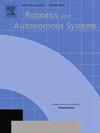Local obstacle avoidance control for multi-axle and multi-steering-mode wheeled robot based on window-zone division strategy
IF 4.3
2区 计算机科学
Q1 AUTOMATION & CONTROL SYSTEMS
引用次数: 0
Abstract
Due to the length of the body, multiple number of wheels and the complexity of controlling, it is difficult for a multi-axle wheeled robot to avoid obstacles autonomously in narrow space. To solve this problem, this article presents window-zone division and gap-seeking strategies for local obstacle avoidance of a multi-axle multi-steering-mode all-wheel-steering wheeled robot. Firstly, according to the influence degree of lidar points on the robot, combining with the human driving characteristics of avoiding obstacles, a window-zone division strategy is proposed. The lidar points are selected and divided according to the degree of emergency. By eliminating irrelevant points, the work of obstacle avoidance calculation is reduced. Thus, this increases the response speed of obstacle avoidance. Based on this, the robot uses a multi-steering-mode to avoid emergency obstacle. Secondly, the gap-seeking theory of normal obstacle avoidance is proposed. It can seek the passable gap among the surrounding lidar points according to the prediction of the robot's driving trajectory corresponding to different steering angles. Thirdly, the on-board control system and the upper computer program of the robot were designed. Thereafter a multi-steering-mode algorithm was designed based on the front and rear wheel steering angles and speed, as well as the travel trajectory forecast-drawing module. Finally, the proposed methods have been implemented on a five-axle all-wheel steering wheeled robot. Some obstacle avoidance experiments are carried out with S-shaped, Z-Shaped, U-Shaped, and Random obstacle distribution. The results show that the proposed strategy can finish all obstacle avoidance successfully.
基于窗区划分策略的多轴和多转向模式轮式机器人局部避障控制
由于车身长、轮子多、控制复杂,多轴轮式机器人很难在狭窄空间内自主避障。为解决这一问题,本文提出了多轴多转向模式全轮转向轮式机器人局部避障的窗区划分和间隙寻找策略。首先,根据激光雷达点对机器人的影响程度,结合人类驾驶避障的特点,提出了窗口区域划分策略。根据紧急程度对激光雷达点进行选择和划分。通过剔除无关点,减少了避障计算的工作量。因此,这提高了避障响应速度。在此基础上,机器人采用多转向模式避开紧急障碍物。其次,提出了正常避障的间隙寻找理论。它可以根据不同转向角度对应的机器人行驶轨迹预测,在周围激光雷达点中寻找可通过的间隙。第三,设计了机器人的车载控制系统和上位机程序。之后,设计了基于前后轮转向角和速度的多转向模式算法,以及行驶轨迹预测绘制模块。最后,在一个五轴全轮转向轮式机器人上实现了所提出的方法。在 S 形、Z 形、U 形和随机障碍物分布情况下,进行了一些避障实验。结果表明,所提出的策略可以成功完成所有障碍物的避让。
本文章由计算机程序翻译,如有差异,请以英文原文为准。
求助全文
约1分钟内获得全文
求助全文
来源期刊

Robotics and Autonomous Systems
工程技术-机器人学
CiteScore
9.00
自引率
7.00%
发文量
164
审稿时长
4.5 months
期刊介绍:
Robotics and Autonomous Systems will carry articles describing fundamental developments in the field of robotics, with special emphasis on autonomous systems. An important goal of this journal is to extend the state of the art in both symbolic and sensory based robot control and learning in the context of autonomous systems.
Robotics and Autonomous Systems will carry articles on the theoretical, computational and experimental aspects of autonomous systems, or modules of such systems.
 求助内容:
求助内容: 应助结果提醒方式:
应助结果提醒方式:


